The following information is summarized from the Northern Colorado Plateau Network monitoring plan, published in 2004. Some details may have changed.
Park History and Purpose
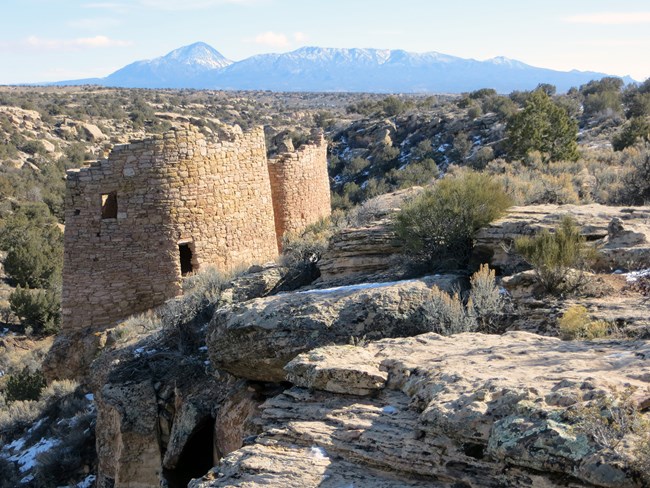
NPS/A.W. Biel
Hovenweep National Monument was first established by Warren G. Harding in 1923, by Presidential Proclamation 1654 (42 Statute 2299). The Proclamation states, in part, “Whereas, there are in southwestern Colorado and southeastern Utah four groups of ruins, including prehistoric structures, the majority of which belong to unique types not found in other National Monuments, and show the finest prehistoric masonry in the United States; and…It appears that the public good would be promoted by preserving these prehistoric remains as a National Monument with as much land as may be necessary for the proper protection thereof…that there is hereby preserved, subject to prior valid claims and set apart as a National Monument to be known as Hovenweep National Monument…”
Subsequent Presidential Proclamations 2924, April 29, 1951; 2998, November 20, 1952; 3132, April 6, 1956; and Public Land Order 2604, February 5, 1962; added other areas and adjusted boundaries. Given the proclamations listed above and the Organic Act of August 25, 1916 (Public Law 235, 39 Stat. 535), the National Park Service mandate is to preserve and protect the cultural and natural resources associated with the six ruin groups, and to assist visitors in understanding the life and culture of the prehistoric inhabitants and their environmental adaptations.
Hovenweep’s resource values consist of significant cultural resources and their associated pristine natural settings. The Cajon, Square Tower, Holly, Hackberry/Horseshoe, and Cutthroat units contain clusters of Ancestral Puebloan pueblos and towers situated near permanent springs at canyonhead locations on Cajon Mesa. These canyon-rim towers and villages are the best preserved and protected, most visually striking, and accessible examples of 13th-century Ancestral Puebloan architecture and community locations within the San Juan River Basin. Other archeological sites representative of Paleo– Indian, Archaic, and early Puebloan occupation are also found. These five units are significant because they possess a high degree of physical and locational integrity. In addition, the towers are noteworthy because of many stylistic variations.
The Goodman Point unit consists of an immense, unexcavated pueblo in the Montezuma Valley. These remains reflect its position as a regional center for the Mesa Verde Ancestral Puebloans, and it is one of the best-preserved sites in the West. It is the first archeological site set aside by the federal government, on September 13, 1889, and represents one of the largest 13th-century villages in the San Juan Basin. These villages contain elements of public architecture, such as great kivas, plazas, reservoirs, and enclosing walls. Hovenweep also contains some of the best examples in the nation of ancient astronomical calendars that mark important seasonal events using architecture, rock art, and sunlight.
Location
Hovenweep National Monument contains six distinct units situated in the Four Corners area. The Square Tower and Cajon units are located in San Juan County, Utah. The Goodman Point, Hackberry/Horseshoe, Holly, and Cutthroat units are located in Montezuma County, Colorado.
Elevation
Elevation varies from 1,585 meters (5,200 feet) at the Cajon unit to 2,060 meters (6,760 feet) at the Goodman Point unit.
Size
318 hectares (785 acres)
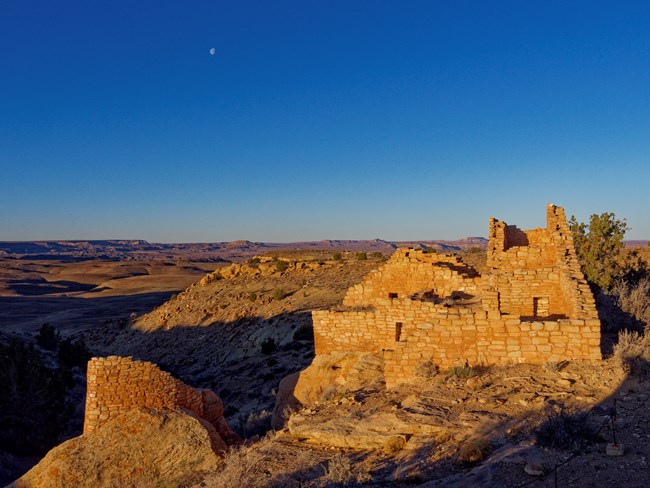
Stephen Bridgehouse
General Description
The natural environment is characterized by rugged topography, with small canyons divided by narrow mesa tops. The primary geologic formation is Cretaceous Dakota sandstone. Shallow-to-deep aeolian soils are found on the mesa tops, with shallow colluvium on canyon slopes, and shallow-to-deep alluvium in canyon bottoms. While permanent water sources are limited, a few springs and seeps in canyonheads produce water year-round. Residual water, trapped in potholes or flowing in washes after rains or snowmelt, is seasonally available.
Five of Hovenweep's six units are on Cajon Mesa, which covers approximately 500 square miles on the Colorado–Utah border near Four Corners. Although topography is fairly uniform, variations in rainfall, soil type, and plant associations occur through minor differences in elevation and drainage pattern. The northern half of the mesa is higher, cooler, and wetter, supporting a pinyon-juniper forest. This part of the mesa is the most productive today, growing dryland pinto beans, winter wheat, and alfalfa.
The climate in this high desert is dry, with an average of 305 millimeters (12 inches) of precipitation per year. Temperatures range from winter lows of -10 to 0°F to summer highs averaging 100–105°F, with a mean annual temperature of 52°F.
Plants and Animals
Visitors may encounter a wide range of native and nonnative plant and animal species throughout the site.
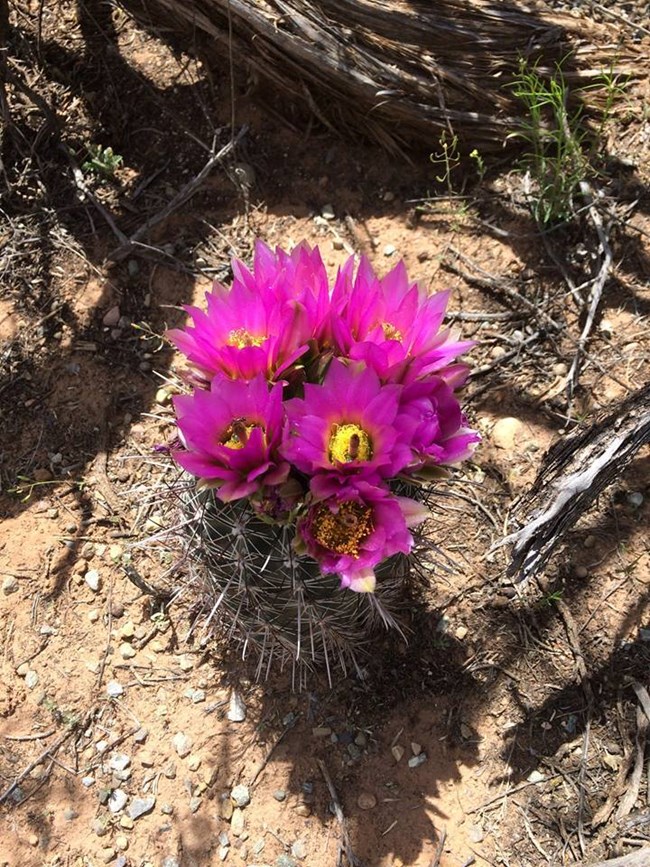
NPS
Flora
The monument contains about 350 vascular plant taxa. Vegetation zones range from shrubland to mixed sage and juniper woodland to pinyon-juniper forest. Riparian communities exist. A thorough plant survey occurred in 2000.
From the early 1900s through the 1940s, all of Hovenweep National Monument was subjected to heavy sheep grazing, eliminating much of the ground cover. Vegetation depletion was followed by soil loss through erosion. Thus, soils are thin and species composition poor. Fortunately, exotic species have not had a significant impact.
Most monument units are in the juniper-sage and sage in the mesa’s midportion. In addition to the above plants, rabbitbrush, cliffrose, Mormon tea, yucca, and serviceberry are common and were important plants to prehistoric Ancestral Puebloans. The area was most heavily occupied by ancient people when they built the settlements preserved at the monument.
Permanent seeps and springs are common in canyonheads that cut the mesa, especially at the point of contact between the porous Dakota Sandstone that caps the mesa and the underlying, more impervious Morrison Shales. The seasonal and permanent springs in the canyonheads are important sources of springtime moisture.
South of Square Tower unit, sagebrush blends into a mixed-shrubland plant zone composed of shadscale, greasewood, snakeweed, and grasses. This zone covers the southern end of Cajon Mesa and the San Juan River Valley. Snakeweed is dominant in some places, especially in overgrazed areas. The Cajon unit is the only part in this plant zone.
The Goodman Point unit lies a few miles northwest of Cortez, Colorado, at a higher elevation, receives more moisture, and has slightly cooler temperatures than other units. The environment is pinyon-juniper forest, surrounded by modern dry farmland producing pinto beans and winter wheat. Parts of Goodman Point unit are almost completely overgrown with a vigorous sage. The unit contains a large spring.
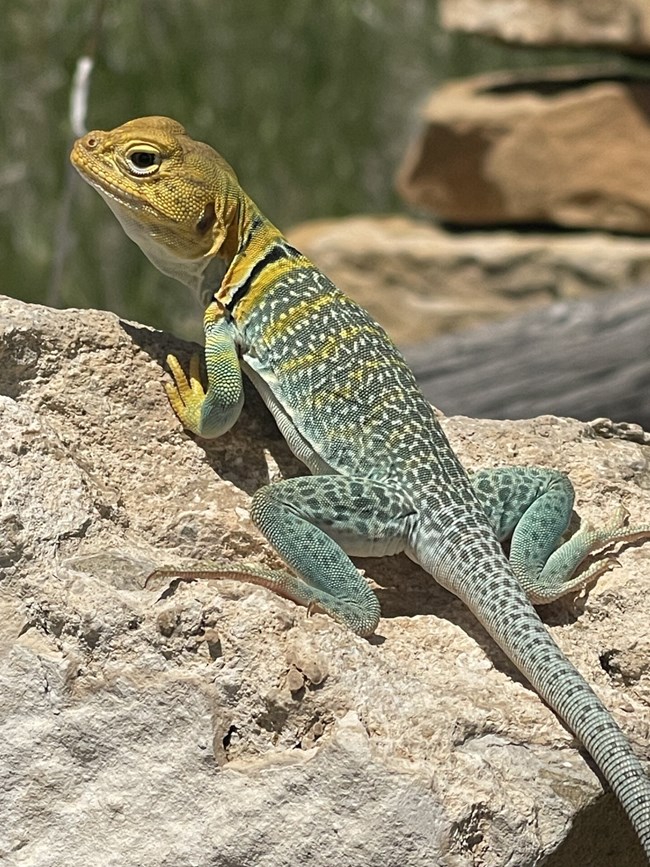
N. Barber
Fauna
The monument is home to over 200 species of mammals, birds, reptiles, and amphibians. Common mammals include mule deer, bobcat, mountain lion, and coyotes. Birds are most numerous in cottonwood and willow vegetation along streams and perennial water sources. The Gunnison sage grouse, a sensitive species, has been observed. Reptiles are found throughout. The most common lizards are the side-blotched and sagebrush lizards. The most common snakes are the gopher snake, western rattlesnake, and striped whipsnake. Amphibians are not common, found only near streams, springs, and rock pools. There are no fish.
Aquatic Features
Very little aquatic activity is noted. Macroinvertebrates are monitored four times a year as part of the water quality monitoring program, started in 1999. Tiger salamanders (Ambystoma mavortium nebulosum) have been observed at some springs.
Unique Features and Species of Special Concern
Plants
Hovenweep National Monument may contain plants of concern. Cronquist's milkvetch (Astragalus cronquistii), Naturita milkvetch (Astragalus naturitensis), and cut-leaf gumweed (Grindelia laciniata) are reported in the general area but have not been found within the monument.
Animals
The Gunnison sage-grouse (Centrocercus minimus), a sensitive species, has been sighted. Mexican spotted owls (Strix occidentalis lucida) and southwestern willow flycatchers (Empidonax traillii extimus) could be found once surveys begin.
Resource Management Concerns
Trespass livestock and exotic plant species are main resource management concerns.
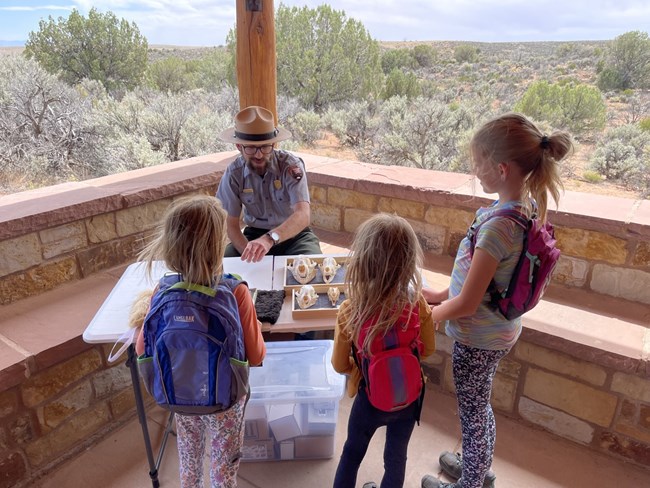
NPS/N. Barber
Recreation Use
Visitor use increased rapidly during the 1980s and early 1990s, causing soil and vegetation damage in heavily used areas. Impacts from visitors hiking off-trail destroy cryptobiotic soils and trample vegetation, which increases erosion.
Land Use Impacts
Agricultural practices surrounding the monument, primarily livestock grazing, are a concern. While the number of livestock that trespass is low, vegetation is damaged and lost through trampling and consumption, and invasive weeds are introduced. Energy resource exploration and extraction is increasing. Around the monument are deposits of oil, natural gas, uranium, vanadium, coal, and pure carbon dioxide. These activities could negatively affect some resources, such as water availability and soils (through contamination). Sound pollution is also a problem from the mining activity. Air pollution has increased in the past 40 years due to coal-burning power plants.
Invasive Exotic Plant Species
There are 27 exotic plant species. The monument is surrounded by agricultural lands and the exotic plant source is high and constant. Tamarisk (Tamarix ramosissima) has invaded canyon bottoms in all units but most of it has been controlled through mechanical cutting and herbicide.
Content was edited and formatted by E. Rendleman.
Last updated: June 27, 2025
